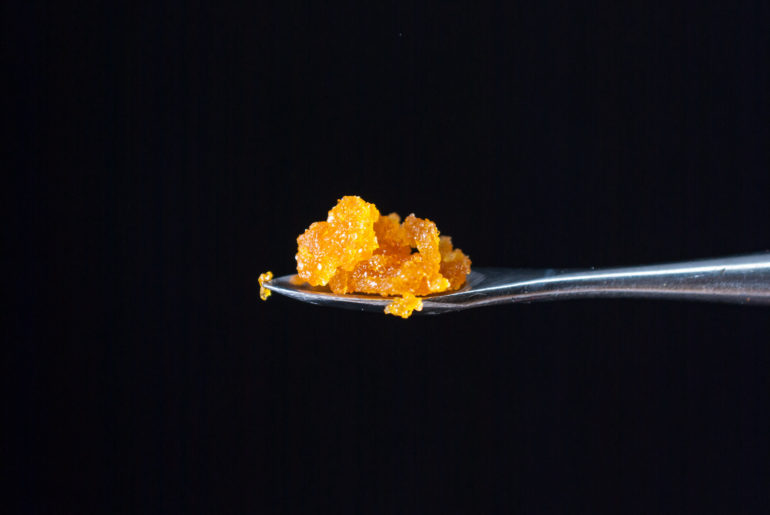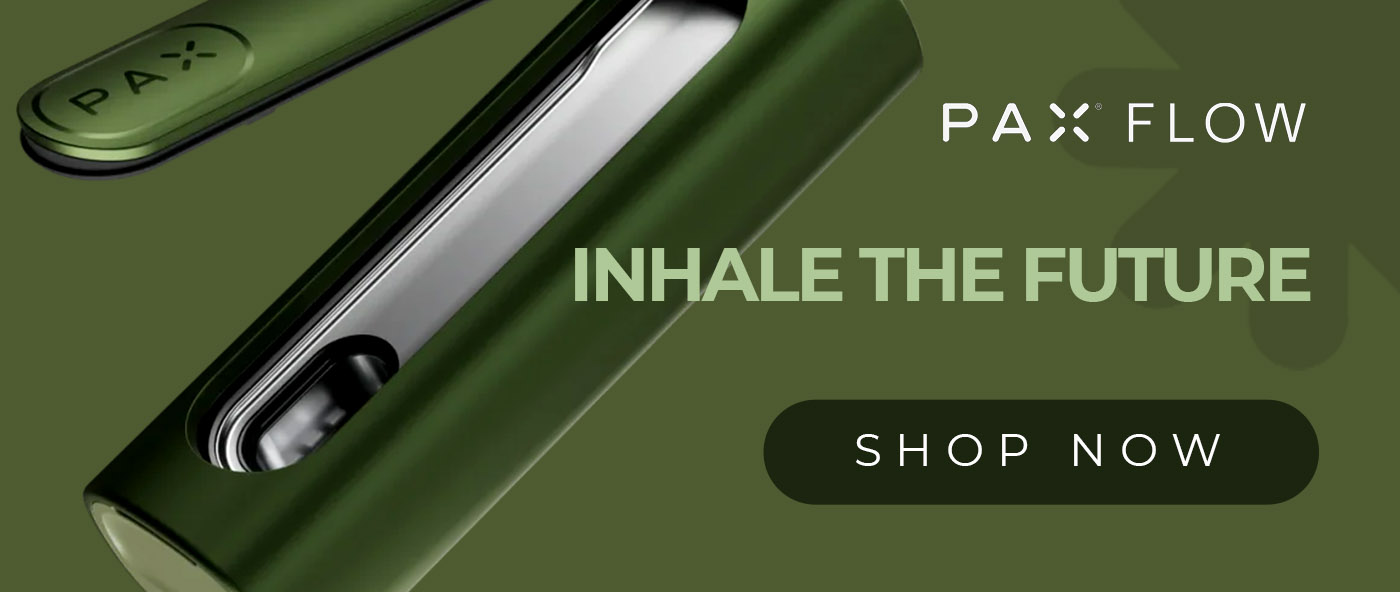Dabbing is one of the most confusing ways to get high for a newcomer. From the terminology down to the practice itself, it feels like there’s a lot to learn before you even know what you’re supposed to be doing. The fact that the word dab is used as both a verb (to take a dab) and a noun (calling THC wax a dab, for instance) doesn’t help either. But after you get through the basics – from “what is dabbing?” through to how to take a dab – things start to make a lot more sense. Here’s everything you need to know about dabs, dabbing and why you’d try it out.
Table of Contents
- What is Dabbing?
- What Are Dabs?
- Types of Dabs
- Shatter
- Wax
- Budder/Batter/Badder
- Taffy
- Crumble
- Live Resin
- Terp Sauce
- Diamonds
- Rosin
- Dry-sift Hash
- Bubble Hash
- How to Smoke Dabs
- What You Need
- How to Get the Dose Right Before Dabbing
- How to Smoke Dabs: Step By Step
- Step 1: Add Water to Your Rig
- Step 2: Heat the Nail
- Step 3: Add Your Dab
- Step 4: Use the Carb Cap
- Step 5: Exhale
- Alternatives to Traditional Dabs
- How to Make Dabs
- What is a Dab Pen High Like?
- Conclusion
- You may also like:
What is Dabbing?
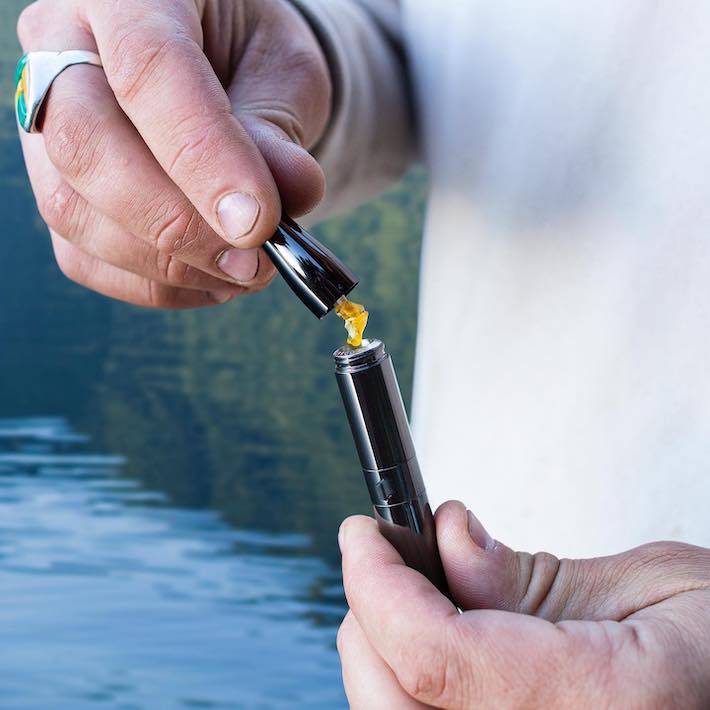
Dabbing is basically the process of “flash” vaporizing cannabis concentrates through a bong-like rig. In a traditional bong, you put ground up cannabis into a bowl and light it in the same way you would a pipe, then inhale it from the mouthpiece after the smoke is filtered through water. A dab rig looks a lot like a bong – in fact, many rigs can do both – but it has a bucket-like “nail” in place of the bowl. This is basically a quartz container that’s connected to a downstem like the bowl on a bong.
Dabbing involves heating this nail to between 400 and 600 °F, then touching a small piece of cannabis concentrate onto the hot surface. This basically vaporizes it instantly, and the vapor is pulled through the downstem, filtered through the water and then brought up to the mouthpiece. So in a sense it is just like a bong, except with a more complicated system for producing the stuff you inhale.
What Are Dabs?
Given the above, you might think that “dabs” are the individual tokes you take when dabbing. Sometimes you might say this, but generally if someone talks about dabs, they mean the form of cannabis you use for dabbing. So you might call a wax weed concentrate a dab, something like “dab wax” or many similar combinations of terms. In short, most types of cannabis concentrate can be considered a dab drug. Although this is technically right, it’s more of a colloquial way of referring to the specific concentrates. In practice – for example, at a dispensary – you’d need to specify which of the types of “dabs” you mean.
Types of Dabs
There are many types of dabs out there, which – as discussed above – really means “types of cannabis concentrates.” Most of these are named based on their appearance or consistency, and generally you’ll have an idea of what you’re getting from the name alone. That said, here is a brief description of the most common types of dabs on the market.
Shatter
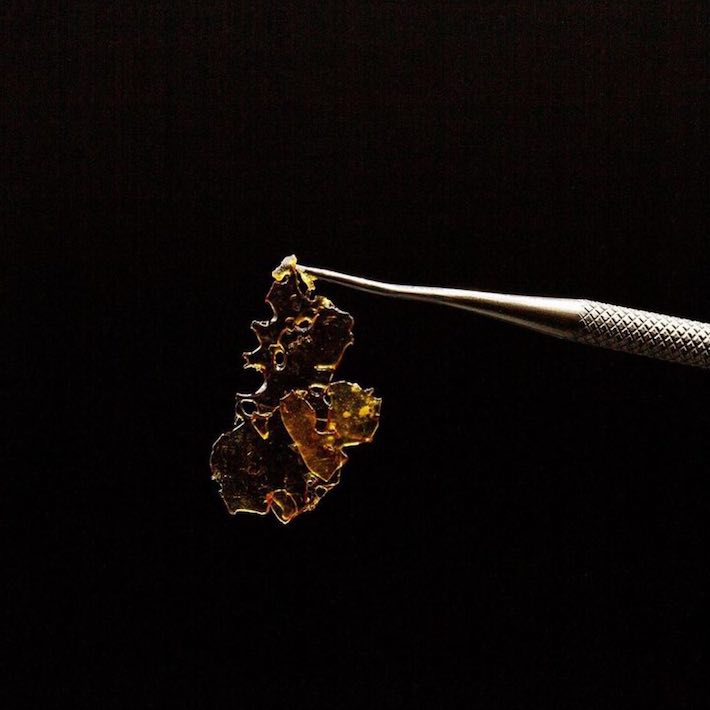
This is a pure, glass-like cannabis concentrate that you can literally shatter if you want to. Like most concentrates, it’s a solvent-based extraction. It’s usually amber or gold in color, but should still be somewhat see-through.
Wax
A dab wax is any concentrate with a soft texture similar to wax. This is something of a broad term, with many of the other types of dabs being called wax in some contexts. Again, this has a gold/amber coloration.
Budder/Batter/Badder
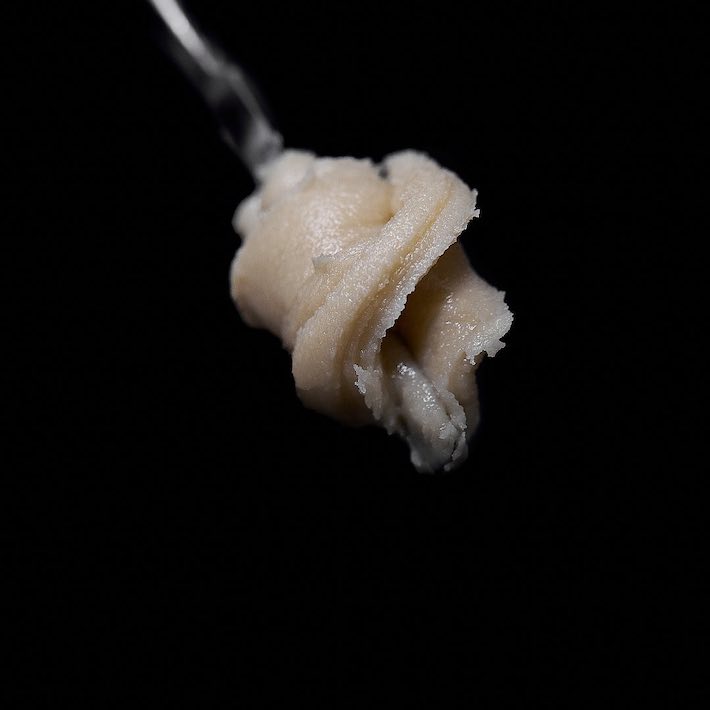
These are three terms for a type of THC wax that has the consistency of cake batter. This is usually lighter gold in color, but the slightly thinner consistency makes it easier to work with.
Taffy
As you might expect at this point, this is a cannabis concentrate with the consistency of taffy. This is like a softer form of shatter, with it being almost identical in cold temperatures but getting more pliable at room temperature and stringy when even warmer. You can literally pull a piece off and snap it like taffy.
Crumble
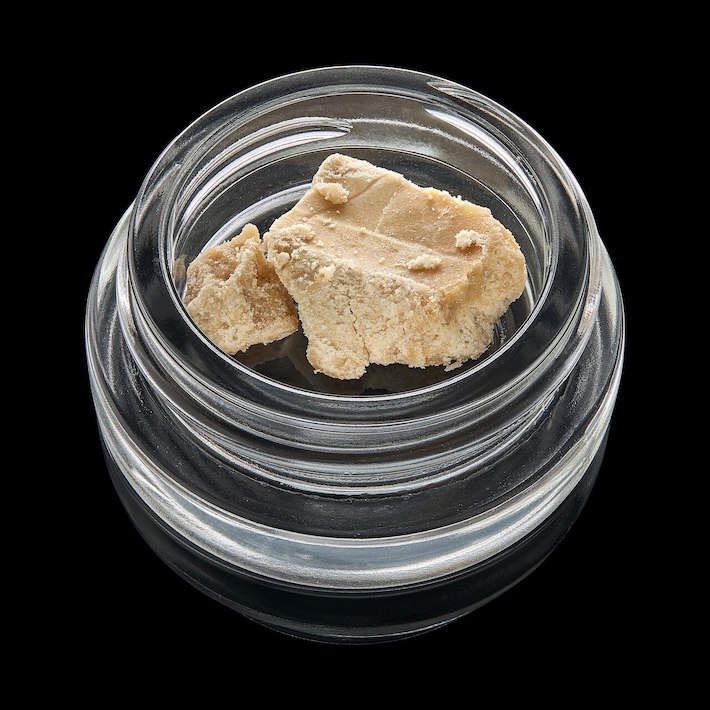
This is a honeycomb-like type of dab wax. The main difference between crumble and other waxes is that it’s drier and breaks apart easily (i.e. it crumbles). The production process is basically the same as shatter except it stays in a vacuum oven for longer, which leads to the characteristic texture. It’s usually a dark yellow in color.
Live Resin
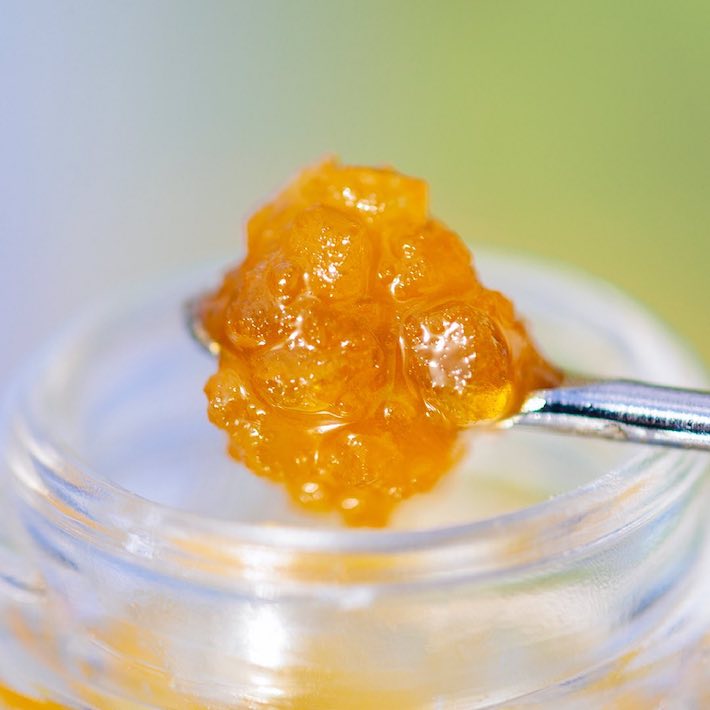
Live resin is basically the result of a process intended to maximize terpenes (which are responsible for the characteristic smell of weed) by freezing the plant at harvest and keeping it frozen throughout extraction. It has the same amber coloration as most types of dabs, but with a thinner consistency than others.
Terp Sauce
This is an oily, gloopy concentrate that is mainly known for being flavorful – which is why terpenes take part of the name. It has a saucy to oily consistency, and is usually amber or lighter in color. There may be pure cannabinoid blocks in the mixture too, which can give a grainier texture.
Diamonds
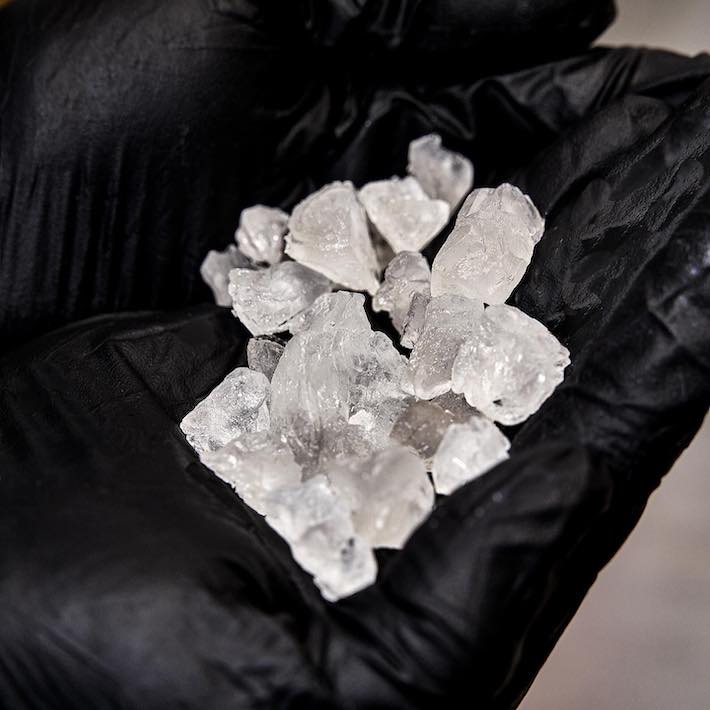
Diamonds are the name given to a pure extract of a single cannabinoid, to the point they become crystalline like a diamond. The single-chemical nature of these makes them a bit of a strange choice for dabbing alone, and may be combined with terp sauce to give some other cannabinoids and the flavor-producing terpenes.
Rosin
This is a type of dab wax made without solvents, by simply pressing the plant material between two heated plates. This produces a pure oil, which can then be allowed to cool with no concerns around removing residual solvents. You can also make live rosin by freezing the plants in an analogous way to live resin.
Dry-sift Hash
This is like a low-tech version of hash, with the trichomes from the plant (i.e. the kief) simply being pressed together. Producers use dry ice to remove the trichomes or simply break it off through agitation. Regardless, this is a form of hash made without solvents such as butane and suitable for either dabbing or smoking.
Bubble Hash
This is similar to dry sift hash, except the plant material is put into ice water and agitated to remove the trichomes. The resulting liquid is filtered numerous times to remove plant matter, and you’re left with a THC-rich, light-blonde to dark brown liquid.
How to Smoke Dabs
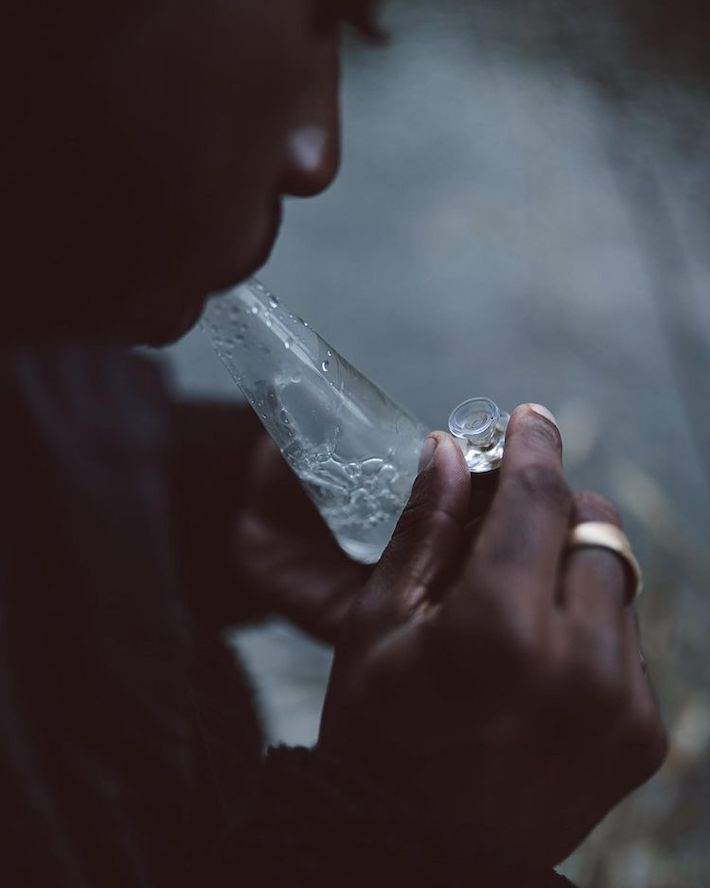
Now you have a good idea of what dabs are and how dabbing works, you can learn how to take a dab. The process is pretty straightforward, but you’ll need some specific equipment to get everything to work efficiently. Here’s a quick run-down:
What You Need
- Torch: A crème brûlée torch or other butane-based torch is needed to heat the nail. You can technically do this with a torch-style lighter but a torch is highly recommended.
- Dab rig: Kind of obvious, but you’ll need a dab rig with a nail to get started. Dab rigs are generally a bit smaller than bongs, but very similar, with a spot for your nail (bucket-shaped quartz ones are most common).
- Carb cap: Although you can dab without a carb cap, it’s a very useful tool for regulating the airflow. This is analogous to how you can pull out the bowl of a bong to change the airflow. Nails are too hot to do the same, but you can cover or uncover with a carb cap.
- Dab tool: You’ll need something to pick up the dab and place it on the hot nail, and there are plenty of options out there. There are scoop-shaped options which are good for runnier dabs, paddle-shaped ones which work well for thicker dabs, and many options between.
How to Get the Dose Right Before Dabbing
Learning how to smoke dabs is mainly about the process, but if you don’t get your dosage right your experience might be too intense (or not intense enough). The challenge is that most types of dabs have very high THC concentrations, generally between 60 and 90%. If you’re in a legal state, the concentrate you pick up will almost certainly have this information on the package.
So imagine you’ve picked up some dab wax with a 75% THC concentration. This means 1 g (i.e. 1,000 mg) of the wax contains 750 mg of THC. The recommended starting dosage for dabs is about 25 mg, which means you only need 1/30th of the gram per dose. So in this case you could split the gram into 3 equal pieces, and then take one of those pieces and split it into 10 equal pieces. This is easier said than done – it’s very unlikely you’ll get it perfect – so if you have a very accurate scale you could just weigh out 0.033 g of the concentrate.
If you’re not in a legal state, you’ll have to either make some assumptions or hope that your dealer gives you information (and that it’s accurate). It’s better to err on the side of caution when it comes to dosing, especially if you don’t have potency information. You can always take another dab, but you can’t untake the dab.
This is good advice in most cannabis-related matters: start low and go slow.
How to Smoke Dabs: Step By Step
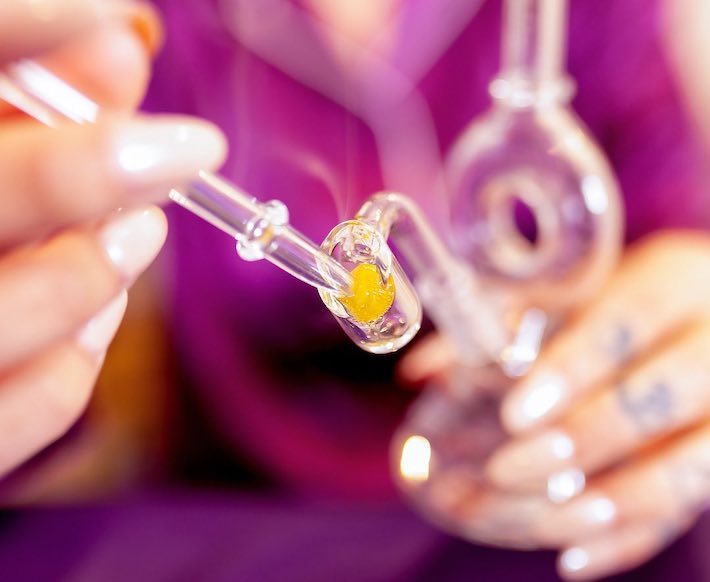
Step 1: Add Water to Your Rig
The first step to taking a dab is adding water to the chamber of your dab rig. You can test the level you have by inhaling without a nail attached to the downstem. If water splashes up into your mouth, the level is too high.
Step 2: Heat the Nail
With your nail attached to the downstem and your dose of concentrates set to one side, start heating the bottom of the nail with your torch. The ideal dabbing temperature is between 545 and 570 °F (285 to 300 °C), and most people achieve this by heating the bottom of the nail until it turns red hot, and then turn off the torch. For quartz nails, leave it for around 45 to 60 seconds to cool down, but for titanium, 10 seconds is enough time. If you want a more specific guide, you can heat for 30 seconds then cool for 60 seconds on a quartz nail (again, 10 seconds is enough cooling for titanium).
Step 3: Add Your Dab
Get your dose of THC wax or other dab on your dab tool and add it to the base of the nail (on the inside) and start inhaling. Twist the dab tool around on the base to make sure you get all of the concentrate off it. When you’re done you can move the tool to one side.
Step 4: Use the Carb Cap
Cover the chamber with the carb cap to stop any of the vapor from escaping in the lulls in your inhalation and to help vaporization by sealing the nail chamber. Using the carb cap properly is a matter of personal preference and experience, but generally you can pull the cap up to give yourself airflow for inhaling and close it off when you aren’t inhaling as much. However, it’s also a good idea to wiggle and rotate it throughout your inhale, to help get air circulating inside the chamber and improve vaporization.
Step 5: Exhale
That’s it. Breathe out and get ready for your 25-plus mg of THC to hit.
Alternatives to Traditional Dabs
If you don’t have a traditional rig, don’t want to place concentrate into a hot nail or aren’t sure whether dabbing is for you, there are a couple of alternatives it’s worth considering.
The first is “cold-start” dabbing. This is basically what it sounds like: the regular process, except you start with the nail cold. You apply your concentrate to the cold nail, cover with a carb cap and then heat the nail from underneath. It usually takes about 10 seconds for it to start producing vapor, then you turn off the torch and start inhaling, while rotating the cap to keep the air flowing. The main downside to this approach is that there will likely be some residue after you’re done, and you’ll need to clean it up before using it again.
The second is to use an electronic dab rig, with an “e-nail” or dab pen that heats up from electricity rather than a pure flame. This reduces a lot of complexity, and makes things safer and easier for anybody unsure about heating the nail with a torch. The rigs themselves can be a little expensive, but if you want maximum convenience it’s a pretty good approach.
How to Make Dabs
Making dabs at home can be an intensive process if you use an extraction-based method, but you can make rosin without solvents and with items you likely have at home anyway. You’ll need:
- 2 grams of cannabis
- Bakery/parchment paper
- Flat iron or hair straightener
- Oven mittens
- Razorblade
First, heat your flat iron or hair straightener to between 250 and 300 °F (120 to 150 °C). Break up your cannabis into four pieces and flatten them down by hand. Place one of the four chunks of cannabis in the middle of a folded-up piece of parchment paper. Put on the mittens to protect yourself, then either press the parchment between the two halves of the hair straightener or place the iron on top of it. Leave this in place until you heat the material on the inside start to sizzle. You’ll get some usable material after a few seconds, but leave it longer if needed.
Unfold the parchment and remove the buds, putting them to one side (you can use it in an edible or to make an oil). Do this same process with each of the buds, noting that there is likely resin building up on the parchment as you go. When it’s done, use the razorblade (or just a sharp knife) to collect the resin for later use.
What is a Dab Pen High Like?
A dab pen high is basically like any other high, except much more intense. You’re taking in more THC than from your average joint but in a much quicker, more direct fashion. Of course, the effects of the dab depend a lot on the dosage you take, but you’ll probably consume more than you usually would if you don’t ordinarily use concentrates.
This is really the same whether you use a traditional dab rig or a more modern dab pen.
So generally a dab pen high will give you the same relaxing, euphoric and giggle-inducing effects as normal cannabis, but more intensely than usual. You might notice some “trippier” effects like distorting your perception of time more than you would after a joint. But overall the experience is the same, just a stronger version of it.
Conclusion
The terminology surrounding dabbing may seem a little confusing at first and the practice itself might look very arcane and complicated, thanks to the bubblers, nails and butane torches, but you should be well-versed now. Really all it means is flash-vaporizing some dab weed on a hot surface and inhaling it through a bong. Of course, there is a lot of detail to pick up as you go – trying different types of dabs and learning to work your carb cap – but this post has hopefully given you everything you need to start off on your journey.
